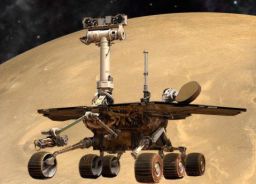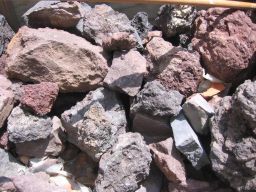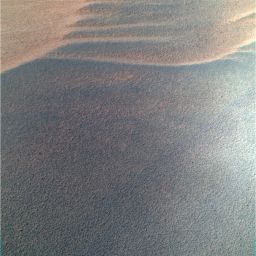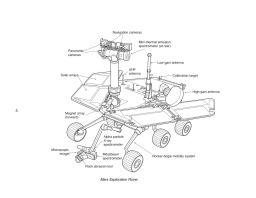A.J.S. Rayl • Jun 30, 2009
Mars Exploration Rovers Update: Spirit Embedded in Paydirt, Opportunity Roving on 'Hot' Wheel
It’s been a relatively quiet but scientifically significant month on the Red Planet for the Mars Exploration Rovers. While Opportunity continued its long journey to Endeavour Crater, forced to take it slower and make longer stops to rest its ‘hot’ front wheel, Spirit, seemingly just biding its time embedded in a sand pit it slipped into in April, turned up one of the most intriguing discoveries on the mission to date.
Spirit is still parked on the west side of Home Plate, the circular, old volcanic formation it’s been studying for more than two Earth years, approximately 3.2 kilometers (2 miles) southeast of where it landed in Gusev Crater on January 3, 2004. The rover’s rocker bogie hasn’t moved one centimeter since the first week of May when the team realized it was mired in sand to its left side hubcaps. It had been on its way south to its next destinations -- a large pit dubbed Goddard and a funky mound called von Braun – when it roved into the troublesome area, nicknamed Troy, and crunched through a crusty top layer with its left wheels and slid into a lush sandpit.
As it tried to rove on from Troy, Spirit only churned up the sand and dug its wheels in deeper, so the team halted all driving until ground tests could be conducted. Serendipity, however, has always been the pass code for the MER mission. “If we had to get stuck somewhere, we picked a damn good place to do it,” said Steve Squyres, of Cornell University, principal investigator for the science payloads on the MERs during a recent interview.
Turns out, the sandy stuff – dubbed Ulysses – coming from three or more layers, distinct in their pastel hues, hiding beneath the darker blanket of red soil – just may be something special. “It’s the most exciting deposit exposed in the whole mission,” proclaimed Ray Arvidson, of Washington University St. Louis, deputy principal investigator for science payloads on the MERs, who generally oversees the daily science activities on Spirit.
“And we're not stuck,” Arvidson insisted. “We were moving, however slightly, when we stopped to do the tests on the ground. Spirit is mobility impaired.”
However anyone defines it, even in “this very bad situation,” as Squyres put it, Spirit found “a substantial silver lining.”
With an abundance of newfound energy and no way to go in June, Spirit spent the month fully engaged, true to its MER nature, studying the incorrigible sands of Ulysses, checking out each layer, each different color exposed. “The more we measure, the better it looks,” Arvidson noted. “We have three different kinds of enriched sulfate deposits exposed in the disturbed material in front of the left front wheel. There are white, yellow, and tan particles, in addition to the normal kind of red basaltic sand.”
Science team members are still debating the hypotheses. This discovery may be evidence of much more recent processes than the formation of Home Plate, Arvidson pointed out. The sandy materials may possibly have been sorted by wind and cemented by the action of thin films of water, for example. Or, it could be that Home Plate is being slowly stripped back by wind, he added, and Spirit just happened to stir up a deposit from billions of years ago before the wind got to it.
Spirit has also been busy taking hundreds of images with its panoramic camera (Pancam) for a new 360-degree panorama, called Calypso. "We have indeed been patiently documenting our surroundings with Pancam while our engineering/rover driver colleagues determine the best way to extract the rover from our current jam,” reported Jim Bell, of Cornell University, the Pancam lead scientist and Planetary Society President, earlier today. “The Calypso Panorama is fully acquired but only about 85% of it is downlinked, so we're still working on it.” [Look for a sneak peek in this Update.]
Despite the bounty of new science, team members, especially the rover drivers, are anxious for Spirit to get out of Troy. A member of JPL's media relations team, John Howard, created a Free Spirit logo to promote the coming extraction event. Reminiscent of the Endless Summer poster with its sunset colors of yellow-orange and red, and rover self-portrait in silhouette, the logo has already roved beyond the JPL webpage that will track Spirit’s extraction action and onto posters, bumper stickers, shirts, and hats.
Spirit's right front wheel, which has been immobile for more than three years, magnifies the rover's challenge. In fact, if the rover had a functioning right front wheel, it “certainly would have moved out of this area some time ago,” noted Jake Matijevic, chief rover engineer. Adding to the concern, Spirit's left-middle wheel stalled during the last commanded move in May. Diagnostic tests in May and earlier this month, however, showed the left middle wheel operating normally. “The real reason for the stand-down,” said Matijevic, “is that we needed a different exit strategy.”
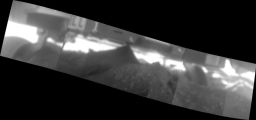 Self image
Self imageSpirit took this panorama of images on its Sol 1925 (June 2, 2009) to help its ground team assess its current state and plan its extraction from the soft soil known as Ulysses in the region called Troy. The rover took the images by reaching underneath it and snapping pictures with it microscopic imager camera mounted on the end of its robotic arm. This is the first time the short-focus MI camera has been used to assist in planning a rover's escape from an embedding event. The imager camera is designed to focus on targets only 6 centimeters (2.4 inches) in front of its optics. As a result, the images in this mosaic are out of focus. It is still very useful for the engineers and scientists. The mosaic, which is rotated to show the true orientation of the rover relative to the local terrain, shows the underside of the rover, the depth to which the wheels are embedded and the terrain itself in sufficient detail. Credit: NASA / JPL-Caltech / USGS
In preparation, Spirit used its microscopic camera, located on the end of its robotic arm or instrument deployment device (IDD) to reach underneath its belly and snap a second set of pictures this month to improve the ground perspective. It took a similar, first set of underbelly pictures on May 30, but this second set offered a little better detail of a rock that may be touching the rover’s belly. After analyzing the pictures, scientists have generally concluded that the rock is loose, not bearing the rover's weight and shouldn't impede the rover's escape. In other words, it doesn’t seem to be as bad as it might look.
Down on Earth, the MER team spent most of June analyzing Spirit's dilemma and preparing a life-size simulation of the rover’s Martian terrain at the Jet Propulsion Laboratory (JPL) where the robot field geologists were designed and built. “It’s where we will test exit strategies with the test bed rover to validate the safest way to proceed on Mars,” said Matijevic.
Since they can’t just go to the hardware store and buy Martian dirt, the crew at JPL is filling a large wooden box structure in JPL’s indoor Mars yard with a ‘sand-in,’ if you will, a mix of diatomaceous earth, powdered, Lincoln 60 fire clay, and play sand to represent Ulysses or the stuff at Troy that snared Spirit.
“It's a lot of work setting this up, laying it out like it looks on Mars, and it’s dirty work, all shovel and wheelbarrow stuff,” said Squyres. “You're talking about literally tons of dirt, very carefully crafted, carefully mixed dirt that has to be put into position, and then the rocks need to be put in the right places. But we're making headway.”
Actually, a few tons of the fake Martian sand components were delivered to JPL last week and a crew began mixing it together and shaping it into contours to replicate the scene on Mars. If all goes as planned, the team could begin commanding the ground test rover through the first of various combinations of maneuvers later this week, Arvidson said.
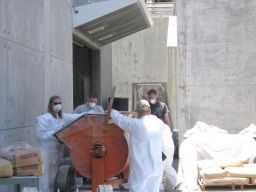 Mixing it up
Mixing it upMER team members mix materials to fill the testbed box. Once filled, the rover will be driven into the test area and set in place to mimic how the actual rover sits on Mars. Escape maneuvers will then be tested to determine how to retrieve the rover safely. Pictured (left to right) are Kim Lichtenberg (from Wash Univ.), Matt Van Kirk (in back in grey t-shirt), Paolo Bellutta (in front) and Mike Seibert (in back in dark t-shirt). Credit: NASA / JPL-Caltech
Spirit may be embedded up to its left hubcaps and handicapped by a frozen steering wheel on the right side, but anyone who knows anything as about this mission knows you never say 'never' with these rovers. Scientists and engineers alike remain positive the rover will gain its independence. "We are optimistic,” said JPL's John Callas, project manager for Spirit and Opportunity. “With the improved power situation, we have the time to explore all the possibilities to get Spirit out. The last time Spirit spun its wheels, it was still making progress. The ground testing will help us avoid doing things that could make Spirit's situation worse.”
In the most optimistic scenarios, Spirit and its team will be celebrating the rover’s freedom by the end of July. “Then we’ll get on with the trek southward,” said Arvidson. Word from Gusev is that it couldn't happen soon enough for Spirit.
On the other side of the planet, Opportunity has been making steady, if somewhat slower progress toward the giant, 22-kilometer (13.67-mile) diameter Endeavour Crater in Merdiani Planum. Its right front wheel has continued to draw higher currents than the rest of the wheels on every drive in June; consequently, the team ordered the rover to take longer rest stops, something that effectively sidelined it for half the month.
“We have been concerned about the elevated currents,” Matijevic said. Since Opportunity has been consistently experiencing these elevated currents in its right front steering wheel actuator for the last several months, it has been incorporating backwards drives and taking rest stops, techniques that allow the lubricant in the gearbox to redistribute. But those mitigation techniques are no longer working as completely as they have in the past. “While they seem to have some effect, it's not a long-lasting effect and they have not been a cure,” he said.
Opportunity's right front wheel is only drawing about twice the current as the other five wheels, not an extraordinary amount. However, this is the same symptom Spirit had some three Earth years ago just before its right front wheel broke for good. And, Opportunity has driven miles and miles with the issue recurring from time to time. “The worry is more about what the future might hold for driving with this elevated current condition,” Matijevic said. “Nothing that we're going to do is going to insure that everything will work by the time we get to Endeavour. But we would like to get to Endeavour and we know that it would be easier to do that if we're a six-wheeled vehicle rather than a five-wheeled vehicle.”
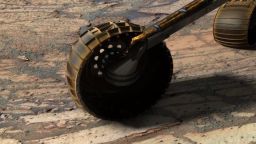 Rove on, Opportunity
Rove on, OpportunityThis rendered image of Opportunity's right front wheel is an image produced using "Virtual Presence in Space" technology, developed at JPL. It combines a photorealistic model of the rover and a false-color mosaic taken by the rover way back on Sol 134 (June 9, 2004) with its panoramic camera while in Endurance Crater. Rover model by Dan Maas, synthetic image by Zareh Gorjian, Koji Kuramura, Mike Stetson and Eric M. De Jong. Credit: NASA / JPL-Caltech / Cornell
To that end, the MER team officials have put together “a little tiger team,” as Squyres described it, to come up with more techniques to keep that right front wheel properly lubricated and the current it’s drawing more in line with those of the other five wheels. Spirit began to experiment with some of them this month.
Throughout the month of June, both Spirit and Opportunity continued in overall good health, with plenty of power to check off the tasks on their agendas. Opportunity continues to produce from 420-to-450 watt-hours, “plenty enough for driving,” Squyres noted, with more than 50% of the available sunlight getting through the solar panels. The real power story this month, like the science story, is all about Spirit.
After nearly two Earth years of taking on dust and all but disappearing into the Martian landscape, Spirit finally was blown away in every good sense of the phrase in April and May this year. A series of gusts, one and two after another, cleared layer after layer of dust from its solar panels. The rover burst into June with around 884 watt-hours of power and as summer warmed Mars, Spirit experienced another gusty gust to see power levels as high as 947 watt-hours toward the end of this month, "That's about what we pulled at the very outset of the mission,” Matijevic noted.
Spirit has been experiencing a sort of trifecta of effects that has led to its astronomically high power levels. “The winds have cleared the solar arrays, so the rover is cleaner, but another impacting factor is that the tau is down, so the skies are clear,” Matijevic pointed out. “And, because we passed the [Martian] summer solstice period, the Sun is higher in the sky each day, there is greater illumination on the panels, and as a result more sunlight is getting through for power production.”
The MER team knew from Viking in the late 1970s that dust comes and goes on Mars and they figured the prospects for the planet's notorious winds clearing dust on the rovers’ solar panels were pretty good. But they had no way of knowing how or when it might or could happen. And no one in his or her wildest dreams predicted that either of the rovers – least of all Spirit – which wasn’t expected to survive the first Martian winter – would be producing five and a half years down the road the same amount of energy it produced on landing.
 Sneak peak: Calypso Panorama
Sneak peak: Calypso PanoramaThe Pancam team at Cornell has been working late these days. This is a sneak peek of Spirit's forthcoming Calypso Panorama, thanks to Pancam team member grad student an Melissa Rice. This peek pan was made with the L2 filter, which has the most images downlinked and calibrated, Rice said. 82 individual frames make up this partial mosaic. Credit: NASA / JPL-Caltech / Cornell
By all accounts, Spirit’s rebound is truly remarkable. Team members can only smile and high-five. Especially considering that just a couple of months ago this rover was being prepped for life support. “It is in a sense like getting a new vehicle,” Matijevic summed up. “It would just be really nice is this vehicle had a working right front actuator.”
Spirit From Gusev Crater
Spirit spent the month of June on the west side of Home Plate in the same solitary position it’s been in since May, its odometer stopped at 7,729.93 meters (4.8 miles), as it awaits instructions from Earth on how exactly to escape the troublesome area the team calls Troy.
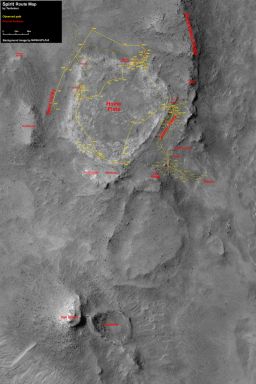 Spirit route map
Spirit route mapThis image taken by the HiRISE camera onboard the Mars Reconnaissance Orbiter has been labeled by Eduardo Tesheiner, an active participant on UnmannedSpaceflight.com, to show Spirit's route from its arrival in the Home Plate area on Sol 743 through Sol 1871 (April 8, 2009), when the rover began suffering a series of bouts with 'amnesia.' Credit: NASA / University of Arizona /E. Tesheiner
The rover slipped into a sandpit at Troy, now known as Ulysses, back in April. Since then, it's been using every instrument it’s got to check out the sandy stuff that pulled in its left wheels. Lo and behold, Spirit's slip into the sand pit now known as Ulysses was a slip of fate.
To recap: While driving south toward its next destinations, a shallow pit and unusual mound named, respectively, for rocket pioneers Robert Goddard and Werner von Braun, Spirit's left wheels broke through a dark, crusty top layer, exposing pastel-colored sandy materials and a miniature cliff that clearly revealed the stratification or layering of cemented sands. On the inside of the break in the crust, the rover's pictures reveal yellow, and tan layers beneath the usual rust red top layer.
The difficulty Spirit is confronting in getting out of Ulysses is also in visual evidence in the pictures it sent home. Specifically, disturbed material obviously cascaded down the cliff, indicating the ‘slipperiness’ or looseness that will make getting out a challenge. But at the edge of the disturbed patch, the soil appears cohesive enough to hold its shape as a steep cross-section, so optimism about Spirit’s eventual successful exit remains high.
When the calendar turned to June, Spirit was in the midst of taking pictures with its microscopic imager (MI) camera, basically reaching with its robotic arm or instrument deployment device (IDD) underneath its belly to document the scene. Since the MI was designed as a short focus camera, it was never meant to take these types of long-focus images. But after Opportunity first tested the technique in April, demonstrating that the images, though blurry, revealed good information and sufficient detail, the team commanded Spirit to do likewise and get a peek underneath.
Spirit collected its first MI mosaic from under its belly on Sol 1922 (May 30, 2009). It showed a rock precariously close to, maybe even jutting into the rover’s belly. The team decided the rover could probably get a better picture. So, after finishing up a study of some of the sandy soils with the Mössbauer spectrometer, Spirit took a second series of underbelly pictures on Sol 1925 (June 2, 2009), this time stretching its arm further under itself to capture more detail. The MER scientists, on closer analysis of the rock with those images, are now pretty confident that it's loose, according to Arvidson, and won’t thwart Spirit’s exit.
Since Martian winds blew away most of the dust that had accumulated on Spirit’s solar panels in April and May, the rover bounded into June with power levels hovering around 884 watt-hours. As result, the rover has increased its work hours from about 1.5 hours two months ago to around 11 hours a sol in June, Matijevic said.
 Squeaky clean array
Squeaky clean arraySpirit took this image of some of the light-toned sand in which it's embedded on its Sol 1933 (June 10, 2009. Note the portion of its solar array in the bottom part of the image. Whatever dust was left was cleaned off later in the month when the rover's power levels soared up close to what they were just after landing in 2004.Credit: NASA / JPL-Caltech
Spirit filled its summer sols collecting MI pictures of sand spots in Ulysses, followed by alpha-particle X-ray spectrometer (APXS) investigations of the targets’ compositions. It also took hundreds of frames destined for the next major, 360-degree color panorama, the Calypso Panorama, and made some targeted, remote sensing observations with the miniature thermal emission spectrometer (Mini-TES). Unfortunately, the mineral-sleuthing Mini-TES cannot see Ulysses, because from the top of the mast the instrument can only look down at angle of 50 degrees below the horizon. There is, however, plenty of other stuff in the nearby vicinity for Mini-TES to remote view and the rover’s got power on its side.
Back on Earth, the files that were lost last month (when a disc drive on an interface system used to run the surface system test bed rover failed) were restored and by the end of the first week of June, the system was back online and ready to go. But when small or so-called “shoebox” tests were conducted with the Mars simulant or fake Martian dirt on hand at JPL, it turned out the stuff was nothing like the stuff in which Spirit is sitting. Team members regrouped, then set out to find and put together a better 'sandalogue.'
A point of correction and interest as far as simulating Martian terrain: although that simulant tested was officially identified as Bag House dust [and reported in last month's Update as such], but it wasn’t, according to Arvidson. “The Bag House dust that we used for Phoenix [mission] is fine-grained sand, but the material in the test bed had pebbles and even cobbles,” he explained. The name Bag House actually comes from how the stuff is produced, he enlightened. “It is a by-product of taking basaltic lava and cinders. A company in California grinds it into different sizes and the dust that flies out is captured in bags, hence Bag House dust. It's not dust by the way,” he added. “It's sand.”
During the first week of June, Spirit used its MI camera to collect a stack of stereo images of a sandy target in Ulysses on Sol 1927 (June 4, 2009), then placed its APXS to analyze its composition. During the rest of that week, the rover moved the mineral-detecting spectrometer to a different surface target for a second integration, and on Sol 1929 (June 6, 2009) took another set of MI images and put the Mössbauer (MB) spectrometer on another target within Ulysses. This spectrometer has a decaying radioactive source, so to collect good data on the iron content of a given target takes more than 48 hours these days.
From its in-depth investigation, Spirit and its team realized the rover just so happened into disturbing some of – if not the most distinctive soil on the entire MER mission – an intriguing mixture of unconsolidated, light-toned material in shades of white, yellow and tan, plus they saw distinct layering or stratification of these sands.
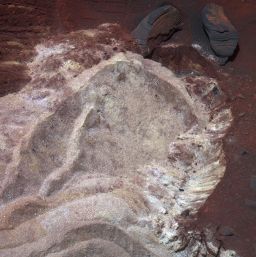 Ulysses in Troy
Ulysses in TroySpirit accidentally slipped through a patch of ground in an area the team calls Troy back in April. Inside the area, the rover churned up a mixture of light-toned soils unlike anything either rover has seen. The variations in this mixture, now called Ulysses, are revealed in pastel hues visible in this panoramic camera (Pancam)image, which has been stretched to emphasize the differences. The rover used its Pancam on its Sol 1892 (Apr. 29, 2009) to take the three images combined into this composite image. The three images were taken through filters centered at wavelengths of 750 nanometers, 530 nanometers and 430 nanometers. Spirit became embedded here about a week later. The two rocks near the upper right corner of this view are each about 10 centimeters (4 inches) long and 2 to 3 centimeters (1 inch) wide.
Credit: NASA / JPL-Caltech / Cornell
Team members from NASA's Johnson Space Center in Houston reported initial readings suggesting that the iron is mostly present in an oxidized form as ferric sulfate and that some of the differences in tints at Troy observed by the Pancam may come from differences in the hydration states of iron sulfates.
Other analyses indicate the presence of calcium sulfate, silica, and other minerals. “Compositionally there's an enhancement of Si02, but whether that's pure silica remains to be seen,” said Arvidson. “We're trying to sort it all out right now.” The stratification of the sandy soils may be harbor deep Martian secrets. “There's a cliff near where we've churned the stuff up and we can see the stratigraphy,” he informed. “The white material, which seems to be a calcium sulfate, is streaming off one of the crust layers.”
“It really is one of the most complex mixtures of things we've ever seen and one of the most interesting places we've ever been,” agreed Squyres. “We've seen ferric sulfates before and we've seen silica before and we've seen the two mixed before and we've seen calcium sulfate before, but we seem to have all those here and mixed together in a very interesting way with some kind of layering,” he elaborated.
As June progressed, Spirit ambitiously studied Ulysses. The rover also conducted more tests of its left-middle wheel just to make sure the stall it experienced back on Sol 1899 (May 6, 2009) was a transient event. It performed a full-rotation test, successfully rotating the wheel one full rotation backwards and more than one full rotation forward, past the point of the original stall on Sol 1933 (June 10, 2009). The wheel moved freely with no re-occurrence of a stall.
Preparations for ground testing extraction strategies for Spirit continued at JPL with engineers and scientists putting a rover wheel through a series of "shoebox" tests of candidate materials with the SSTB rover in the indoor Mars yard, or, the In-Situ Instrument Laboratory or LISL as it's known around JPL. “We were essentially driving one wheel into the material to check for the effect, how easy it was for the vehicle to move itself out,” said Matijevic. “These were about a wheels' diameter in size and a little bit greater in width, so it was a fairly small structure with material in it and the tests served as a kind of preamble to a full-blown test.”
“We want to simulate the wheel sinkage we see on the flight data from Spirit and also the clogging, how the sand sticks on the wheels,” Arvidson expounded. But the ‘sand-in’ soils weren’t working, so the team went in search of something else.
Power has become an issue once again for Spirit, only now, however ironically, it’s because it has an overabundance of it and not because it’s close to running on empty. All revved up, the rover had no choice this month except to burn the midnight oil, making extensive nighttime observations, to burn energy as much as anything, Matijevic confirmed.
Working overtime can have drawbacks for a robot every bit as much as it can for a human. “In nighttime observations, we have to be careful to make sure we've got the heating done correctly for the instruments before we turn them on,” Arvidson noted. “That takes a lot of time. The vehicle can overheat from staying up for a long time, so we have to be careful about those calculations. It's rather different and complex planning now than it was just a couple of months ago. But it’s still fun.” And, the nighttime observations can produce some really interesting data.
“One of these days, you'll probably see a little movie of Earth and Venus showing up in the night sky,” Matijevic said. “It’s kind of a nice analogue to some of the other pictures we've had over the years from other missions.”
“We've been doing six or seven observations in the night of Earth and Venus,” confirmed Arvidson. “It's really interesting, from a public point of view, but also give science information on atmospheric opacity.”
What kind of scientific information about the opacity does it give?
“We've found we can see them,” Arvidson quipped. The scientific analysis, he said, will come later.
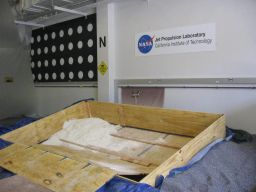 Mars in a box
Mars in a boxThis is a picture from inside the JPL In-situ Instrument Laboratory where the Mars rover simulator is under construction. The test box is angled at 10 degrees, the same angle at which Spirit is positioned on the surface of Mars. It is 8 feet by 20 feet and will be filled with material of similar consistency to that found on Mars, where Spirit is embedded.Credit: NAS / JPL-Caltech
By the middle of June, engineers and scientists had settled on a Mars ‘sandalogue.’ “There were a few [samples] tested before the final mixture was selected,” said Matijevic. Of course, there were many combinations tested during the 2005 Purgatory Dune extraction preparations. “That experience helped streamline the activity this time," he added.
The winning concoction – which team members validated in the single-wheel or "shoebox" tests with the ground test rover – is a combination of diatomaceous earth, powdered, Lincoln 60 fire clay, and play sand, much like what was ultimately used to get Opportunity out of Purgatory.
As several tons of the faux Martian soil arrived at JPL last week, a construction team was at work refining a special test form to hold the new soil simulant and re-creating of Spirit's immediate area. “We decided to create a box-like structure to hold this material in place a little better when we're going through the process of trying to drive out of it,” Matijevic said.
Back on Mars, Spirit filled out the month with its investigations of Ulysses, taking images and composition spectra of five distinct sand targets within the mixture, including Olive Branch, Olive Tree, and Penina. It also spent quality time taking more pictures with the Pancam for the new Calypso Panorama, used its Mini-TES to check out more nearby targets, and took more pictures of Earth and Venus in the night sky.
On Sol 1941 (June 18, 2009), Spirit took a series of pictures with its MI camera on a spot in Ulysses dubbed target Penina3, for example, then put its APXS on the target to analyze its mineral makeup. The next sol, it switched to the Mössbauer Spectrometer and put that on a different target for a multi-sol integration. The rover moved its arm and investigated another set of surface targets on Sols 1945 and 1946 (June 22 and 23, 2009), again by taking pictures with the MI camera, then following-up with an APXS analysis to tease out its composition.
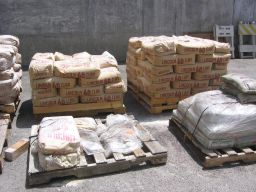 Diatomaceous earth and clay
Diatomaceous earth and clayDiatomaceous Earth and Lincoln 60 Fire Clay, pictured here shortly arfter arrival at JPL, are mixed with play sand to create an Earthy substitution for the Martian sands that have snared Spirit. The mixture on Earth will be poured into a form in the testbed where the team will practice exit strategies for the mobility-impaired rover.Credit: NASA / JPL-Caltech
“When we see layering and this kind of concentration of materials that we know can be mobilized by water, it makes us immediately start to think about aqueous processes that could have operated here and how they might be responsible for what we're seeing,” Squyres offered. “But I think it would be premature to try and spell out in detail what those processes were until we've worked through it and collected all the data. We've done enough work to recognize that we've got a hell of an interesting place here, a very interesting scientific story. Now we're very methodically going through the steps we need to work it out.”
“We have two working hypotheses,” Arvidson elaborated. “We're on the west side of Home Plate and the rocks above us to the east, the kind of basalt rocks we've looked at elsewhere, are dipping into Home Plate. One hypothesis is that we've churned up strata that are beneath everything else in Home Plate. That would mean these light-toned crusts represent a lower strata dipping toward and underneath Home Plate and we just cut into them with the left side of the vehicle because that's where they're exposed,” he suggested. “Another possibility is they represent relatively young crusty material where fluids have been remobilized long after Home Plate was finished.”
Spirit is working with everything it’s got to determine which theory is true and what past environment left this ‘footprint.” It certainly has the energy.
If when it rains, it pours on Earth, then on Mars, when the wind blows, it really blows. Spirit experienced another Martian kiss of wind on Sol 1946 (June 23, 2009) that blew whatever lingering remnants of the fine Martian dust remained on its solar array, pushing the power levels past 945 watt-hours, "getting close to what we had on landing in 2004," said Matijevic.
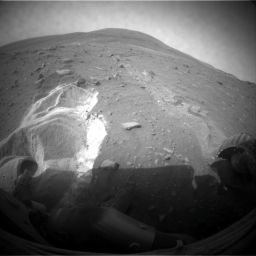 Mobility impaired
Mobility impairedDuring attempts to extricate itself from a patch of soft ground over a period of about two and a half weeks from April into May, Spirit made little progress. By Sol 1899 (May 6, 2009), it had succeeded in partially burying some of its wheels. The rover took this image with its front hazard-avoidance camera that same sol. It shows the position of the rover when the team temporarily suspended driving attempts to study the ground around Spirit and plan simulation tests of driving options with a test rover at JPL.
Credit: NASA / JPL-Caltech
Who could have imagined five and a half years ago that Spirit – which wasn’t expected to survive the first winter because of power issues – would be boasting some of the highest levels of power on the mission this far down the road?
“Beyond the rover’s clean arrays, it’s summer time on Mars, when the Sun is right overhead, and the tau [a measure of dust in the atmosphere] is low so the sky is very clear right now,” noted Squyres. With all the dust-cleaning events, it is a real trifecta of effects that has translated into beau-coup power for the rover some people almost wrote off last year. “It's crazy,” summed up Squyres.
Crazier still, the abundance of power may well continue through September, added Matijevic.
“Even though there were observations of dust removal on certain features of the lander and on the grounds in the area of the landing sites during the Viking mission, no one could really speculate as to what was actually taking place and with what regularity," noted Matijevic. With MER, they have gathered evidence for several different versions of what is generically known simply as ‘a dust cleaning event,’ he pointed out. The rovers have experienced big overnight events that effectively 'dry clean' the vehicle with wind, for example, as well as repeated small brushes with gusts that bring incremental changes, something Opportunity experienced regularly while in craters. The twins have also survived heavy, storm winds that clear the arrays, then deposit dust right back on them. This time, Spirit seems to have found itself in an area where the winds get “sort of funneled,” said Matijevic.
Positioned as it is between Tsilokovsky and Home Plate, the winds tend to come out of the northwest toward Spirit, Arvidson elaborated. “A kind of Venturi effect occurs here. In other words, I think we're in a little wind chute,” he said. As a result, Spirit has been cleaned by the winds, its solar array restored to speckless condition.
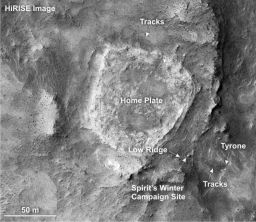 Home Plate from above
Home Plate from aboveThis image from the Mars Reconnaissance Orbiter's High Resolution Imaging Science Experiment (HiRISE)camera shows the area in the Inner Basin of the Columbia Hills that Spirit is currently roving around. It is now on the west side or to the left of the circular volcanic formation in the picture. Credit: NASA / JPL / Cornell
As wonderful as that has been, for Spirit to so abruptly go from surviving on power so low it initially was defined as unsurvivable to an overabundance of power in a matter of weeks, has been equal parts joy and challenge.
Although the rover isn’t going to spontaneously combust or anything like that, Spirit could theoretically over heat. “With a perfectly clear sky, no dust at all, and the Sun directly overhead, the rover is still safe,” “It can't damage itself, assured Squyres.
"But there are two things," he continued. "First, all this power is a gift.Everybody's focused quite properly on getting the rover unstuck from its current location and moving on. Spirit is in a bad situation and we shouldn't play that down. But the fact is we're also in one of the most scientifically rich and interesting places either rover has ever been with more power than either rover has ever seen. It would be nuts not to make the most of it. The team is working very hard to take full advantage of the situation.”
At the same time, Spirit is now brimming with "just about the highest power levels we've seen on either rover," Squyres admitted. "It's really challenging to deal with this much power. It is causing thermal problems and the team is working very, very, very hard to try and manage all the power.”
This past weekend, Spirit conducted studies of the crustier basalt sand to the right of Ulysses, homing in on a spot dubbed Cyclops' Eye, in between the two wheels. This week, if all goes as planned, the rover will use its rock abrasion tool (RAT) to brush and/or grind into the spot.
In preparation for the task, Spirit checked out its RAT Late last week. The instrument was last used on Sol 1489, noted Matijevic. “The checkout on Sol 1947 (June 24, 2009) verified that there was no further loss of capability in the instrument,” he said. In other words it's working fine. The rover also completed a detailed analysis of Cyclops’s Eye to make sure it's going to be safe. “It’s not pure rock,” Arvidson explained. “It's soil with little pebbles.”
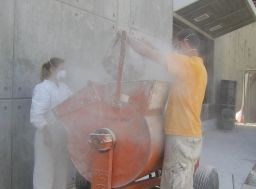 Making Martian sand
Making Martian sandMER team members Kim Lichtenberg (left) and Mike Seibert fill a mixer with powdered clay and diatomaceous earth, a combination found to offer physical properties similar to the soil where Spirit is embedded on Mars. The team finished mixing the test soil and preparing a sloped testing area on June 29, 2009, and planned to drive the test rover into it June 30. Credit: NASA / JPL-Caltech
After all was checked out and analyzed, Spirit was cleared to dig in. “It will do a RAT brush on Cyclops’ Eye 3,” Matijevic confirmed today. “We want to remove the basaltic sand to see if we can find the top of these sulfate layers,” Arvidson explained. “They are probably strata that are an older part of Home Plate. But it's more sulfur than we've seen in the mission.”
During the final days of June, the special test box was installed in the indoor Mars yard, and Mars team members rolled up their sleeves, mixed up the simulant and are now shaping a few tons of the stuff into an exact replica of the area in which Spirit rover is embedded tens of millions of miles away. “This is intended to allow the entire vehicle to be immersed in the new aggregate or soil simulant,” said Matijevic, "like Spirit is on Mars."
“What we have is not an exact replication,” Arvidson pointed out. “We can reproduce the topography and how the soils are churned up and loose on the left side of the vehicle relative to the right. But we'll never exactly replicate the mechanical properties of the soil. On the right-hand side, we're tamping it down to simulate the hard crust that the right side wheels are on. The left side, we're leaving it kind of fluffy. We're doing the best we can.”
Recreating the conditions here on Earth in the testbed is important for testing the Free Spirit escape plans, even if it isn't a perfect simulation. The testing of the exit stratiges could begin, Matijevic said, as early as this week.
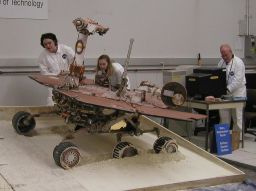 Rolling in
Rolling inWhile a test rover rolls off a plywood surface into a prepared bed of soft soil, rover team members Colette Lohr (left) and Kim Lichtenberg (center) eye the wheels digging into the soil and Paolo Bellutta enters the next driving command. The test rover became embedded in the soil during this June 30, 2009, activity, as intended. The test setup simulates the situation that Spirit faces in a soil patch called Ulysses in an area known as Troy on Mars. The team planned a few adjustments to more closely match the rover's situation, such as placing a rock beneath the test rover, and then intended to begin assessing possible maneuvers for Spirit to use getting free from Troy. The test facility is in the In Situ Instrument Laboratory at NASA's Jet Propulsion Laboratory.
Credit: NASA / JPL-Caltech
Meanwhile, over in Germany, MER science team member Lutz Richter, of the German Aerospace Center (DLR) – who has been studying the stability and stratification of the upper Martian soils traversed by the rovers throughout the mission – has been also conducting tests with a MER-like wheel.
“Once we get the scene set up, the strategies on the table, then we'll spend maybe a couple of weeks testing,” said Squyres. “There are not an infinite number of things we can do, so we won't be at this for too long.”
“What counts are the differential results,” said Arvidson. “We’ll try driving out along the old track, and crabbing to go down hill. We’ll try moving back and forth first to create some socket space in the wheels, and whatever else seems likely and do a differential comparison to see which works the best.”
“And whatever works best,” Squyres bottom lined, “we'll try on Mars.”
With an escape route in hand, and contingencies and back-up planned, rover drivers will see the drop of the flag and the extraction action will begin. In the meantime, the team is psyching up, sporting t-shirts and hanging little posters of the Free Spirit logo created by JPL media rep John Howardp.
How soon might Spirit rove free? The optimistic escape window, said Arvidson, is before the end of July. When the rover does win its freedom, it will continue south to Goddard and von Braun.
opportunity from meridiani planum
Opportunity has been keepin’ on keepin’ on, roving ever southward toward Endeavour Crater. Although the right front wheel actuator or motor continued to draw about twice as much current as normal, the robot field geologist literally roved out of May and into June with a series of blind drives, each with regular slip checks for progress.
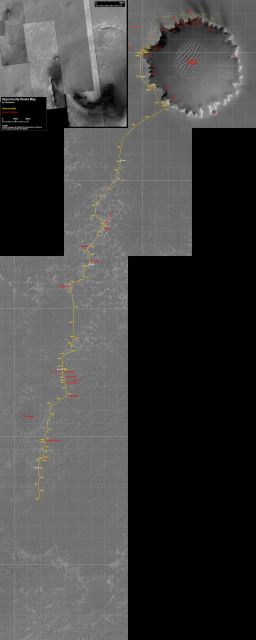 Opportunity route map
Opportunity route mapThis image, taken by the HiRISE camera onboard the Mars Reconnaissance Orbiter (MRO) was labeled by Eduardo Tesheiner to chronicle Opportunity's route from Victoria Crater to where the rover was on Sol 1900 (May 28, 2009, on its journey to Endeavour. It moved another several hundred meters to the south this month. Credit: NASA / JPL-Caltech / UA / Eduardo Tesheiner
On Sols 1900, 1902 and 1904 (May 29, May 31 and June 2, 2009), Opportunity drove 66, 71 and 74 meters, (217, 233 and 243 feet), respectively. But on Sol 1905 (June 3, 2009), it only made it about 30 meters (98 feet) when time ran out. It wasn’t the rover’s fault and no glitch occurred. It was just a time-constrained day. The rover made up for it the following sol, completing a 69-meter (266-foot) drive due south.
Opportunity rested its wheels from Sol 1907 to Sol 1909 (June 5 to June 7, 2009). But it kept busy conducting observations with the panoramic camera (Pancam) and taking atmospheric measurements of argon, which makes up about 1.6% of the Martian atmosphere, with the alpha particle X-ray spectrometer (APXS).
As the second week of June got underway, Opportunity drove south on Sol 1910 (June 8, 2009), but stopped the drive early because the current threshold was exceeded. The next day, the excess draw was traced, not surprisingly, to right-front wheel motor current. It wasn't enough to stop this rover for long. Two sols later, Sol 1912 (June 10, 2009), it took a nice long, backward drive.
Although backward driving has consistently reduced Opportunity’s high wheel current in the past, this time it didn’t seem to have much impact on the level at all, even though it was a 72-meter (236-foot) drive. “The right front wheel actuator us drawing twice as much current, but it's twice as much of a small current,” Matijevic clarified.
The current is a measure of the work the actuator assembly is doing as the rover is moving along, he explained. “The typical no-load current for this wheel, just enough current draw by the actuator to turn the wheel if it were freewheeling, is about.2 or .25 amps,” Matijevic explained. “When Spirit is driving along, the other wheels don't draw much more than that, .25 to maybe .3 amps, while the right front draws something like .5 to .6.” The draw may not be all that demanding, but the right front wheel actuator current level has been elevated now on every drive and that cannot be ignored.
“The concern is more now, because the strategies we've used in the past to mitigate this – reverse direction driving and resting or stand-downs – don’t seem to be having the same effect as they have at other times,” Matijevic said. “Are we putting more wear on this wheel? Are we promoting an eventual failure of the wheel if we continue to operate it when it's drawing that much more current? It's a lot of those kinds of unknown things that we're attempting to try and address here.”
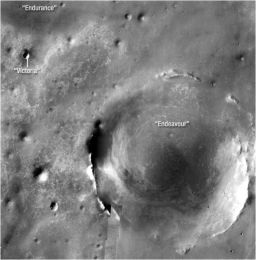 Opportunity's next big destination
Opportunity's next big destinationThe MER team chose a crater more than 20 times wider than Victoria Crater as Opportunity's next destination. The rover began the long, 16+ kilometer journey on Sep. 26, 2008 with a 152-meter drive. The crater, which is to the southeast of Victoria, dominates this orbital view from the Thermal Emission Imaging System (THEMIS) camera onboard the Mars Odyssey orbiter. Victoria is the most prominent circle near the upper left corner of the image. Principal Investigator Steve Squyres originally estimated the rover's trek would take about 2 Earth years with science stops along the way.Credit: NASA / JPL-Caltech / ASU
The rover began late in May to limit its drive distance and employ regular, short, backward slip checks and so far those techniques seem to have kept the current draw from getting any higher. But, as Matijevic put it, they haven’t been “a cure.”
This month, the team ordered Opportunity to take longer rests. “The idea is that this will allow lubricants in the wheel more time to creep and flow from places where they are where they're not needed back into places where they are needed, like in between gear teeth,” Squyres said.
Through the middle of the month, while Opportunity cooled its wheels, it collected more data on bedrock and soil for the systematic sample campaign between Victoria Crater and Enedeavour. “We've done a fair amount of resting and while we've done that we've done IDD work,” confirmed Squyres. “There's nothing particularly special about the places where we stopped to do the IDD work, but as we make our way towards Endeavour, we are monitoring the character of the rock and the soil as we go. We're traveling over a long distance and looking to see if we can spot any trends in composition. As long as we're stopping and resting, it makes sense to collect data.”
On Sol 1913 (June 11, 2009), Opportunity collected a set of microscopic imager (MI) pictures of the sky, called sky flats, to calibrate the camera. The rover also opened the shroud of the miniature thermal emission spectrometer (Mini-TES) to expose the instrument's dust-contaminated elevation mirror to the Martian environment, in hopes the Martian wind would oblige and clear the mirror since purposefully vibrating the instrument failed to remove so much as a speck. It was only a test. Nothing happened. Nothing good. Nothing bad either. The team decided to make a habit of opening it every possible sol.
With time opened up on its science agenda, Opportunity also conducted a Mars seismometry experiment on Sol 1915 (June 13, 2009). “In essence, we turned the IMU – Inertial Measurements Unit – on,” said Matijevic. “Since that unit is combination of accelerometers and gyros, if we turn it on and don't move, we’re letting the accelerometers measure if there's any shaking or displacement of the vehicle as a consequence of sitting still on this terrain.”
The rover didn’t keep the IMU on for long, “maybe a half hour or so,” Matijevic said. But the point was for Opportunity to take the measurements and see what levels registered in these acceleration measurements. This is a short time with an instrument that's kind of crude for this application, but it's one of the things we can do with the equipment we have,” he explained. And why not? If there had been, say, an earthquake at that specific time, Opportunity would have turned into a rover Richter scale and registered it. As it was, it didn’t detect any seismic activity.
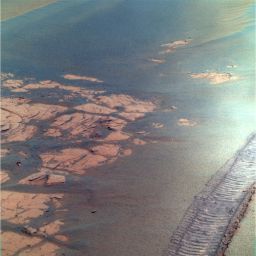 Bedrock and soils to sample
Bedrock and soils to sampleOpportunity took this image with its Pancam during a rest stop late this month on its Sol 1923. It was rendered by the Pancam team in false color to better show show the bedrock and blueberry-rich landscape it is sampling from Victoria Crater to Endeavour Crater.
Credit: NASA / JPL-Caltech / Cornell
Opportunity used its MI to collect images of target "Ios" on Sol 1918 (June 16, 2009), then positioned its APXS on it for an overnight study of its composition. Once that study was completed and with Independence Day on the horizon for the MER team, the rover received marching orders to head toward a large patch of rock outcrop. It would rest there, as its ground team takes off for the July 4th holiday weekend.
On Sol 1920 (June 18, 2009), Opportunity headed for the patch, driving backwards about 63 meters (207 feet). After a few sols of rest, on Sol 1923 (June 21), it drove another 7 meters (23 feet) to an intermediate stop of outcrop. Each was a forward drive with some backward motions, according to Matijevic. The right front wheel currents were still elevated, but were still not “divergently increasing.”
When Opportunity is roving along on a long drive, the motors generate a certain amount of heat, as does the friction of the bearings and gearboxes, so the actuator does picks up some temperature increases as a consequence of driving. If you were on Mars and touched that wheel, the Martian temps notwithstanding, it would be warmer to the touch, though the wheel wouldn't be hot to the touch by definition up there. “It doesn't get burning hot or anything like that; that's not how the system works,” said Matijevic. “And the outside temperature never gets above like 10 degrees C,” he reminded. “The wheels, like everything on the rover, go through a diurnal cycle, so it’s going to get real cold at night and warm up during the day as the air temperature increases.”
Opportunity conducted some close-up observations of surface targets there with the MI camera and the APXS on Sols 1924 and 1925 (June 22 and 23, 2009), then took off again on Sol 1927 (June 25, 2009). It drove for about 65 meters (213 feet), reaching the chosen region of large rock outcrop where it will spend the red-white-and-blue-American holiday checking out the bedrock and soil. “It’s a good time for a rest for the wheel and to hunker down and do some IDD work,” said Squyres.
The drive was, like most of the others this month, forward with backward motions in between. “We were trying to do a little bit of an experiment with the drives where we interrupt the general motion by moving in the opposite direction to change up the general motion of the gear train on the theory that that may help this lubricant flow into the gearboxes,” Matijevic explained. “We think we might be able to do to accelerate this process or to rest more productively, if you will.”
For the first time, Opportunity also tried another tact this past weekend. It warmed up its right front actuator. “We think that when it's warmer, the benefits of resting will accumulate more rapidly,” said Squyres. “The idea is that when you're trying to get these lubricants to flow back where they're supposed to be, like most lubricants, they flow more easily when they're warm than when they're cold.”
Actually, they heated the right side of the rover’s mobility system, Matijevic pointed out, because in order to heat the right front drive actuator, you need to heat all drive and steering actuators on the right side of the vehicle. They warmed it up, he said, “for about 30 minutes within a 1-hour period” on Sol 1929 (June 27, 2009).” Within that hour, temperatures rose from –8 degrees C to 33 degrees C,” he said. “The right side of the vehicle returned to ambient temperatures within about 2 hours thereafter.”
On Sol 1930 (June 28, 2009) Opportunity ‘bumped’ or moved a short distance of about 7 meters. The heating on Sol 1929 did result in slightly decreased currents, Matijevic reported, "about 0.05A reduction in both average and raw currents on the right front drive actuator on Sol 1930." As to whether or not the technique was measurably beneficial, he said "further attempts at heating/driving are needed" before a conclusion could be drawn.
The MER team is considering other techniques to alleviate the high current being drawn by the right front actuator, including changing the turning rate or drive rates – the rpm’s – of the right front wheel to see if that might have some effect, Matijevic said.
“Something else we are considering is 5-wheel driving, letting that right front wheel rest while we drive,” informed Squyres. “All we would do is disable that wheel, not power it. It would be a way to rest the wheel, let the lubricants flow and at the same time make some progress toward Endeavour. But we have not committed to this yet and are only considering it,” he stressed.
One of the things they're worried about with that approach is that as Opportunity drags the wheel, it could stress the wheel or the IDD, which is hanging out in the front of this rover. "This is something we may not do," Squyres added. "We're analyzing it and thinking about it. The point being if in the images sometime in the next week or two or three or whatever, you see us driving and dragging Opportunity's right front wheel, don't conclude that wheel has died,” he said. “We may just be resting it.”
The Mini-TES team is watching and waiting these days. “We are now opening the shroud on a daily basis,” said Amy Trueba Knudson, a research specialist at Arizona State University and associate research scientist for the Planetary Science Institute, who oversees the science on this instrument for this rover. “We usually open it after a morning of activity and leave it open through the afternoon and overnight,” she said. “Although, sometimes it is just open for a short period in the afternoon, when we expect the atmospheric conditions to be the most likely to produce winds,” she added.
The instrument team is monitoring changes by taking Mini-TES data once per week, but so far have seen nothing of note during the two weeks that they've been opening the shroud. “However, we haven't seen any evidence of wind activity on the rover as indicated by changes in the dust factor on the solar arrays,” Knudson pointed out. “What we're really looking for is any change after we see changes in the dust factor on the solar panels. Even then, if the Mini-TES is pointing the wrong direction, we might not see any change on the mirror dust. The plan now is to continue this indefinitely. It may take a long time to opportunistically catch the wind.”
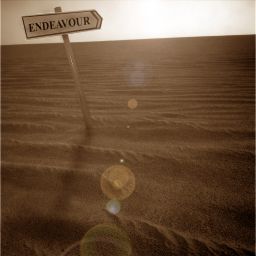 Onward
OnwardOpportunity continued its long journey to Endeavour this month, though it had to make longer stops to rests it right front wheel. This image, which the rover took with its Pancam was enhanced with humor by Stuart Atkinson, a space enthusiast from the United Kingdom.
Credit: NASA / JPL / Cornell / Stuart Atkinson
It was a bit of a tough month for Opportunity. Even the already long route to Endeavour changed this month – and it got longer.
“We could see more of these larger sand dune forms in the HiRISE images, so there was a discussion this month as to whether we should take a greater detour around this area as opposed to wending our way through the worst of it and have a shorter path to take,” Matijevic said.
They opted to err on the side of caution. “We have decided to take a somewhat more roundabout route than we originally wanted to take,” Squyres confirmed. “Along the route that we'd like to take, there are just too many big drifts and dunes and if we wandered into those with a bad wheel we could be in trouble. There are other routes we can take that are a little longer but are much better in terms of the terrain challenges that they present."
From its current Fourth of July post, Opportunity, with 16.71 kilometers (10.38 miles) on its odomoeter, now has, according to Matt Golombek, of JPL, MER science team member, 15.2 kilometers (9.44 miles) to go along the revised route to Endeavour. It’s the long road home. But, noted Squyres: “It’s the path of least resistance.”
Support our core enterprises
Your support powers our mission to explore worlds, find life, and defend Earth. You make all the difference when you make a gift. Give today!
Donate

 Explore Worlds
Explore Worlds Find Life
Find Life Defend Earth
Defend Earth


